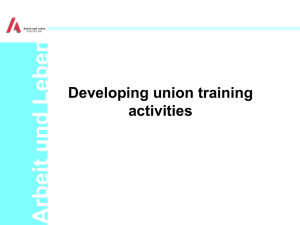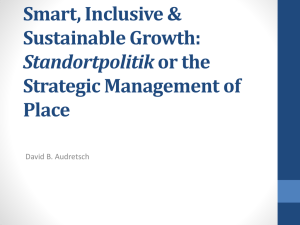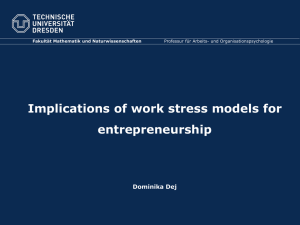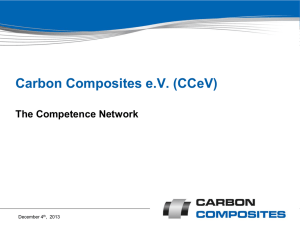Bosch Presentation - The state of manufacturing
advertisement
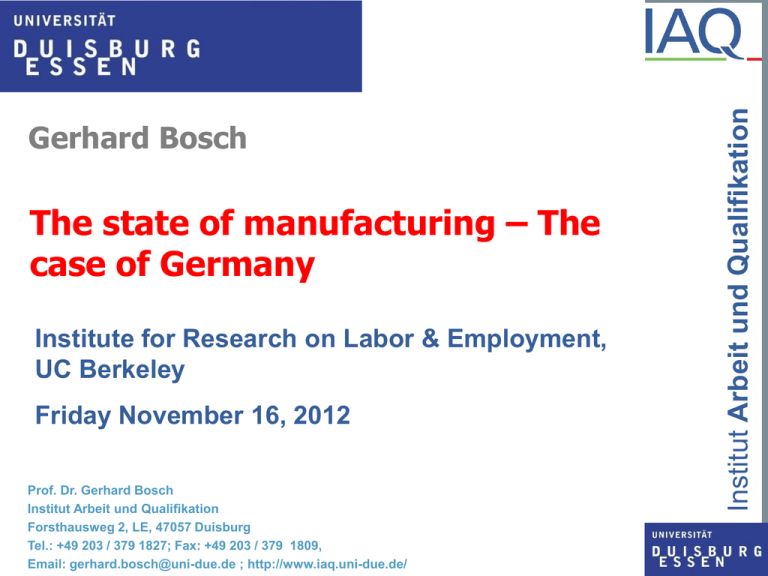
The state of manufacturing – The case of Germany Institute for Research on Labor & Employment, UC Berkeley Friday November 16, 2012 Prof. Dr. Gerhard Bosch Institut Arbeit und Qualifikation Forsthausweg 2, LE, 47057 Duisburg Tel.: +49 203 / 379 1827; Fax: +49 203 / 379 1809, Email: gerhard.bosch@uni-due.de ; http://www.iaq.uni-due.de/ Institut Arbeit und Qualifikation Gerhard Bosch 1. Characteristics of German manufacturing 2. Reasons for its recent success 2.1 Wage restraint without danger of re-valuation 2.2 Innovation 2.3 High skill level 2.4 Internal flexibility 3. Challenges and Risks Institut Arbeit und Qualifikation Structure of presentation 1. 2. 3. 4. 5. Relatively high share of manufacturing in GDP Diversified quality production: specialisation in growing medium-tech industries (automobile, machine-tool…..) Combination of high investments in innovation with manfacturing in own country – not mainly blueprints as smaller countries - Sweden or Finland High shares of internal (within manufacturing) and external tertisarisation Off-shoring overall neutral or positive effects on employment (however, differences by industries) Institut Arbeit und Qualifikation Characteristics of German manufacturing Austria Germany Japan USA France Italy United Kingdom Institut Arbeit und Qualifikation 1.2 Shares of manufacturing in GDB in international comparison (1991-2010) 1.3 Share of value added versus BERD Intensity – Average annual growth, 1995-2006 (Germany) (1) High-Tech and MediumHigh-Tech sectors are shown in red. ‚Other transport equipment‘ includes High-Tech, MediumHigh-Tech and MediumLow-Tech. (2) ‚Basic metals‘ and ‚Fabricated metal products‘ are not visible on the graph. Source: DG Research and Innovation Long tradition of wage moderation to support exports in Germany Until introduction of Euro continuous re-valuation of DM reduced trade surpluses Since 2000 stagnation of real wages and unit costs in DE – because of high unemployment after unification and labour market reforms (Hartz-IV) Increasing trade surpluses of DE and trade imbalances within Euro-Zone because of this defacto de-valuation - one reason of Euro crisis If countries with trade surpluses (China, DE) do not develop doemstic demand – high share of manufacturing unsustainable Institut Arbeit und Qualifikation 2.1 Reasons: Wage restraint without danger of re-valuation Italy Ireland Spain Portugal Greece France Germany Institut Arbeit und Qualifikation 2.1.1 Unit Cost (nominal, in EURO 2000=100) Balance of payments in Billion Euros Surpluses Austria Belgium Germany Netherlands Spain Portugal Italy Deficits Greece France Ireland Institut Arbeit und Qualifikation 2.1.2 Increasing differences in balances of payment in the EURO Zone Most innovation indicators show high innovation performance : - For example: world market relevant patents, expenditure for R&D, share of skilled employees, share of companies/SME‘s with product or production process innovation etc. Relative weakness in high-tech-industries proved not to be a problem Lead market in important industries Special characteristics: High diffusion of innovation across the - economy also in SME‘s Strong family ownership with patient capital (Mittelstand) and long-term business models Institut Arbeit und Qualifikation 2.2 Reason: Innovation Source: European Commission 2012 Institut Arbeit und Qualifikation 2.2.1 EU Member States‘ Innovation Performance Source: German Federal Ministry of Education and Research 2010 Institut Arbeit und Qualifikation 2.2.2 Gross domestic expenditure on research and development as a percentage of gross domestic product in selected countries, 1991 2008 Quelle: Bundesministerium für Bildung und Forschung, 2012 Institut Arbeit und Qualifikation 2.2.3 World-Market Relevant Patents: D, EU-27, J, USA 2000 - 2009 per Milion Inhabitants (registered in Europe and by World Intellectual Property Organization) Share of un- and semi-skilled employees went down from about 65% in 1964 to around 15% 2010 Manufacturing industries employs mainly skilled workers (also for jobs which are done by semi- or unskilled workers in many other countries) Acculumulation of tacit knowledge and high functional flexibility because of high job tenure Middle managers mostly have a certificate from VET plus promotional training or tertiary education Good communication flow from shop floor to engeneers/managers and vice versa Low shares of graduates from tertiary education no disadvantage due to modernized VET „Facharbeiter“ secret of competitiveness – not second choice for bad school leavers Institut Arbeit und Qualifikation 2.3 Reason: High and appropriate skill levels Source: BiBB (Mikrozensus , Statistisches Bundesamt, Berechnungen und Darstellungen ) QuBe-Project2008 Stayer external professionals without vocational training School/ training Institut Arbeit und Qualifikation Total Teaching occupations Health, social work a. personal hygenie occupations Media, human a. social sciences a. creative occupations Legal, managerial a. business occupations Technical a. scientific occupations Clerical a. administrative occupations Catering a. cleaning occupations Transport, logistics a. security occupations Distribution a. merchandising occupations Machine and plant operation a. maintenance occupations Processing and repair occupations Extractive occupations 2.3.1 Skill levels in main occupational and professional activities 6,000,000 5,000,000 4,000,000 Number of employees 3,000,000 Number of apprentices 2,000,000 *5.9 % *6.0 % 1,000,000 *5.7 % 0 332,367 2008 Source: BIBB, Datenreport 2012, Tables A10.1-28-30-Internet 326,932 2009 309,781 2010 *Apprenticeship rate Institut Arbeit und Qualifikation 2.3.2 Employees, Apprentices and Apprenticeship rate in the German manufacturing industry 2008 - 2010 share of the 25-to-64-year-old working population in skilled jobs (ISCO 1-3 Managers, Professional, Technicians and Associate Professionals) and share of the 25-to-64-year-old population with tertiary education (2006) 50% share of the 25-to-64-year-old working population in skilled jobs 45% share of the 25-to-64-year-old population with tertiary education 40% 35% 30% 25% 20% 15% 10% 5% 0% Source: Müller BiBB Institut Arbeit und Qualifikation 2.3.3 Share of population in skilled jobs and share of population with tertiary education (2006) Contrasting business models: USA external, DE more internal flexibility In DE long tradition of „Dismissing hours not employees“ - over last 20 years new tool box negotiated betweeen social partners: - most collective agreements allow temporary reduction of standard weekly w-hrs. (metall industry from 35/38 hrs to 30/33 hrs) - 50% of entreprises have working time accounts (for overtime hrs. etc. ) short-time – subsidized by employment office German Job „miracle“ in big recession because of internal flexibility Short time scheme = Industrial policy to save the industrial fabric of the country Institut Arbeit und Qualifikation 2.4 Reason: High internal flexibility 100 90 80 70 60 50 40 30 20 10 0 Source: http://www.conference-board.org/economics/database.cfm EUROSTAT (2010a). Institut Arbeit und Qualifikation 2.4.1 Percentage of fall in total labour input due to fall in working hours per employee, Germany, 2008–2009 Institut Arbeit und Qualifikation 2.4.2 Production of manufacturing sector (2005=100) 1,600,000 1,400,000 1,200,000 1,000,000 800,000 600,000 400,000 200,000 0 Feb 09 March Apr 09 May 09 Jun 09 Jul 09 Aug 09 Sep 09 Oct 09 Nov 09 Dec 09 09 3 months 3 to 6 months 6 to 12 months Source: Brenke, Rinne and Zimmermann (2010). 12 to 18 months Over 18 months Institut Arbeit und Qualifikation 2.4.3 Short-time working by duration in months, Germany, February 2009–December 2009 % 50 total 1,000,000 45 40 950,000 35 30 900,000 25 20 850,000 15 10 800,000 5 750,000 0 Jan 09 Feb 09 Mar Mar 09 09 Apr 09 May May 09 09 Jun 09 Jul 09 Aug 09 Sep 09 Oct Oct09 09 Nov 09 Dec 09 Jan 10 Feb 10 employment machine tool industry employment automobile industry share of short time machine tool industry in percentage share of short time automobile industry in percentage Source: own calculation Mar Mar 10 10 Institut Arbeit und Qualifikation 2.4.5 Employment and short time in machine tool and automobile industries, Germany, 1/2009 – 5/ 2010 2.4.6 Changes of working hours and employment in relation to changes of GDP 1991-2009 in DE and USA Germany Working hours per employee Volume of working hours Employment Source: Schaz and Spitznagel, 2010 USA 1. 2. 3. 4. 5. 6. Macro-economy: Stability of the Euro-Zone - No development of domestic demand in DE Technology: Possibly new innovation push through „High Tech Strategy“ of government One main goal: „Smart Factory“ (Cyber-Physical production systems) Capital: Increasing short-term thinking due to changes in ownership – capital may get „impatient“ Delocation: Disconnection between R&D and production in own country Skill bottlenecks: Ageeing, underinvestment in education/training – lack of skilled immigrants Academic „drift“: Declining reputation of dual system of apprentices-ship Institut Arbeit und Qualifikation Challenges and risks
